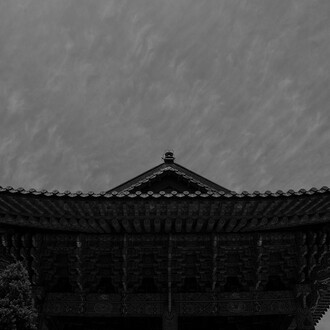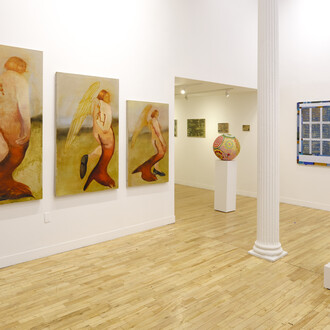This exhibition will feature a total of 6 artists: 2 artists who are based in South Korea, and 4 artists who are based in New York. It will showcase both traditional and contemporary folk paintings.
Meekyung Shin and Sangchul Shin are the two artists from South Korea. Meekyung Shin won the grand prize at the Joseon Folk Painting Contest and will be exhibiting works that she created in collaboration with Riot Games. Sangchul Shin’s works physically dismantle and recombine Hangul (Korean characters) consonants and vowels. The four New York based artists participating in this show are: Seongmin Ahn, Hyunjoo Cho, Kate Oh, and Min Kim.
Haesun Jung’s Korea Traditional Dance Company will be showcasing a special performance on the day of the reception. It will be a Tal (Mask) dance which is a Korean traditional performance that was recently designated by UNESCO as an “Intangible Cultural Heritage of Humanity Performance”. Additionally, 15 Rutgers’ students, who enrolled in Kate Oh Trabulsi’s Minhwa Course, will participate in this show as well.
A Dovetailing of the Traditional and the Contemporary by Ekin Erkan
Rutgers' "Korean Folk Art Traditions" exhibition (Dec. 20 - 30, 2022), spearheaded by Kate Oh Trabulsi and featuring myriad artists (i.e., Seongmin Ahn, Hyunjoo Cho, Min Kim, Sangchul Shin, Meekyung Shin, Jaime K. An-Wong, Aryaan Bari, Heather E. Barr, Mallory C. Collins, Kirra Curtin, Zhishan Dong, Karen M. Falcones, Noel Jackson, Andrew Kang, Mary J. Kim, Geneva Lawson, Elaine Lin, Raphael Tamayo, Ziyang Wang, and Richard Wong) is a tour-de-force through manifold modes of, as the eponymous title suggests, Korean folk art. However, this is not merely an exercise in historical reflection, as each artist engages with contemporary themes, ranging from post-modern identity to semiology, and techniques. The “traditional” facets of Korean folk art serve as anchors, not barriers.
Kate Oh Trabulsi is, herself, renowned for her art practice, which draws on motifs, media, and composition anchored in traditional Minhwa painting, often spurring these into a subtly contemporary mode. Historically, Munjado paintings were popular throughout the Joseon Period (1392–1910) ) and were characterized by combining these characters with symbolic images that promote Confucian values. There are specifically eight Confucian values that Munjado paintings draw upon: filial piety, sibling affection, allegiance to the King, trust between friends, propriety, loyalty, integrity, and a sense of shame. Certain animals play a symbolic role in Munjado paintings—for instance, the Confucian value of “filial piety” is often graphically indexed via the allegorical use of carp and bamboo shoots. As viewers of the exhibition will note, the animal motif is serviced throughout these artworks, always rooted in a historical tradition that belies mere decoration.
Oh Trabulsi and her compatriots are similarly informed by another critical Korean folk art tradition—Minhwa. Oh Trabulsi has, for much of her artistic career, vividly engaged with Minhwa painting. A genre of Korean folk art from the late Joseon era (viz., the 17th-19th centuries), Minhwa paintings draw on Korean mythology and theology, often licensing ornamentation while, like Munjado, making inventive use of symbols. Minhwa paintings’ symbolic elements speak to emotional states of being, including love, delight, glee, fervor, and anger. With its roots in the Joseon Dynasty, the Minhwa style is often regarded as a populist style of Korean painting. This is due to historical circumstances: between the 19th and 20th centuries, Minhwa rose in popularity under a growing merchant and civilian middle class. Until the middle period of the Joseon Dynasty, Minhwa artworks had been relegated to the domain of court specialists, with Minhwa adorning sumptuous palace walls and ceilings. With the aforementioned socioeconomic shift, anonymous artists from the lower socioeconomic classes began working in the Minhwa tradition. Concurrently, Minhwa saw a thematic shift from decorative embellishment to those steeped in the common people’s desires for prosperity—not simply material prosperity, but emotional satisfaction. Hence, Minhwa painting began to take on a new face, with everyday surroundings and customs taking center-stage.
The artists comprising this exhibition include six professional artists, two of whom are based in South Korea and four of whom are based in New York. The fifteen Rutgers students presenting their work were under Oh Trabulsi’s erudition during the course of the past semester, and have thus developed a similar penchant for stitching the traditional and the contemporary. A number of these artists go further than Oh Trabulsi in their admixture of contemporary media and Korean themes. Notably, Meekyung Shin was recently awarded the grand prize at the Joseon Folk Painting Contest, and exhibits a collaborative intermedia piece. Shin Sangchul’s work appropriates and combines dismantled Hangul consonants and vowels, working in a tradition of pictographic and ideographic art (i.e., the “verbal visual”) that, for Western audiences, is often (incorrectly) regarded as inaugurated by Dadaist artists or twentieth century artists such as Robert Indiana and Chryssa.
In fact, the “verbal visual” is perhaps the unifying theme amongst the myriad works in this exhibition. The aforementioned two putative pioneers, Chryssa and Indiana, only speak to the “verbal visual” within the Anglo-American sphere, with subsequent Western artists like Jenny Holzer, Barbara Kruger, and Richard Prince taking up the mantle. Yet this exhibition reveals that it is a mistake to see pictography and ideography as a resolutely Western phenomena. Instead, its roots are illuminated by recourse to calligraphy, such as Seoye. During the Goryeo and Joseon dynasties, utilitarian ware were often inscribed with Seoye brushstrokes, with padlocks, incense burners, porcelain, lacquer, and branding iron adorned in script that served both aesthetic and semiological purposes. One particularly unique work in this exhibition reads “You are delusional", turning to Latin script while gracing each letter with tangerine and blush-coral blossoms, a dovetailing of two received traditions often distinctly conceived. Another piece reads "League of legends", a play on the popular video game series that is composed in identical fashion to the actual lettering of the series itself; again, however, the letters are coated and buoyed by traditional motifs, including a wide-mouthed serpentine dragon unspooling a goblet of fire veering through the "S" letter, flaxen fish arching and spiraling down the tail of a river that is the letter "G".
Although not every piece draws on the history of semiology and written language as such, even the prismatic portrait of a soft-eyed figure, whose eyes and face refract variegated letters, makes use of this dovetailing technique. One notable exception is a particularly intriguing work that features three sprawling, out-pouched floral arrangements, crowned by a soft malachite that is almost wave-like, the middle peach-skin burgeoning, and the lower a golden lemon that bounces light. The backdrop is a pure vermillion and out of the middle flower structure peers a curious, beady-eyed figure, almost reminiscent of the howling figure from Edvard Munch's The Scream (1983). Each artist progresses the amalgamation of the traditional and the contemporary that Oh Trabulsi is duly acclaimed for.



















